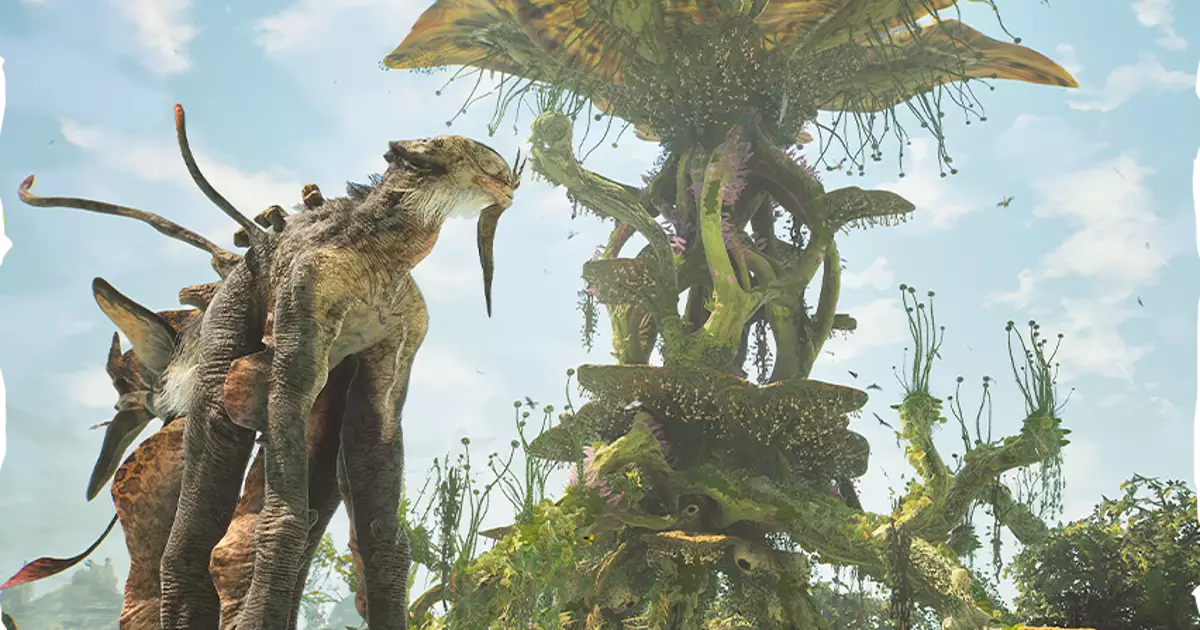Towers of Aghasba, the open-world ecotribal adventure from the developers Dreamlit, has caught the attention of gaming enthusiasts with its visually captivating previews. Slated for release on November 19, 2024, the game paints a lush, equatorial landscape teeming with vibrant flora and ancient creatures. While on the surface it appears to offer an enchanting experience filled with exploration, village-building, and creature interaction, a deeper reflection raises questions about its potential shortcomings and the fundamental nature of its gameplay.
Set within an aged ecological harmony, players step into the shoes of a junior architect of the Shimu tribe. The objective? To revive ecosystems adversely impacted by a shadowy antagonist known as the “Withered.” The visuals presented so far boast stunning environments characterized by vivid colors and unique, exotic creatures that evoke a sense of wonder. The presence of mini-games like gardening, crafting weapons, and nurturing or eliminating fantasy beings generates an intriguing premise.
Yet, as I absorb these features, I can’t help but ponder how deeply they resonate with the gaming community, particularly those who have grown weary of style over substance. The design offers a nirvana for fans of aesthetics, but a compelling narrative or innovative mechanics could inevitably propel or stunt its success. Anecdotally, we’ve seen games that are colorful and engaging in trailers falter upon full release when they lack meaningful interactions or a solid framework.
A notable aspect of Towers of Aghasba is its underlying themes of environmental stewardship and fantasy. Players are encouraged to connect with nature, whether through restoring habitats or caring for delightful creatures such as a pastel-colored dragon. However, one cannot ignore the potential for a heavy-handed approach to these themes.
The balance between “eco-positivity” and engaging gameplay mechanics poses a significant challenge. Narrative depth in games that promote such themes is essential; otherwise, players might feel patronized. Will players genuinely connect with the lush world, or will it come off as a superficial attempt to preach environmentalism without sufficient context?
The game’s description suggests a rich ecosystem worthy of exploration. Still, the question lingers: how effectively will Towers of Aghasba simulate this interconnected web of life? Addressing scenarios such as food poisoning for the creatures would add an unexpected realism that could enhance immersion.
Towers of Aghasba offers real-time combat mechanics, drawing parallels to those found in other successful titles through the familiar use of combos, dodging, and archery. However, there’s a risk that this formula could regress into redundancy common in many survival games. The crafting elements seem present but reportedly not as central to gameplay. This raises concerns about player engagement and progression: how impactful can combat be if players aren’t genuinely incentivized to develop their skills?
Moreover, while the notion of cooperative support sounds appealing for group enthusiasts, it also begs the question of player experience. Will co-op enhance the narrative, or will it dilute individual storytelling? A nuanced approach to multiplayer experiences can result in immersive or superficial interactions that affect player retention substantially.
Dreamlit’s portrayal of tribal themes and their cartoonish presentation raises questions regarding cultural representation. The game captures an organic visual style, but does it reflect genuine cultural appreciation or merely borrow aesthetic elements? As the gaming community becomes more discerning and advocates for respectful representation, it’s crucial for developers to approach such themes with depth and consideration.
The use of holographic templates for building—while aimed at accessibility—could undermine the organic feel of creating structures that blend seamlessly with nature. A grounded, intuitive building system would align better with the game’s thematic aims while offering players genuine creativity in crafting their environments.
As the launch date for Towers of Aghasba approaches, I find myself oscillating between excitement and skepticism. Dreamlit’s vibrant visuals and the allure of exploration provide a promising foundation. However, concerns about gameplay depth, thematic execution, and cultural representation loom large. Here’s hoping that when we finally glide into the verdant realms of Aghasba, we discover not only beauty but also a richly woven narrative that compels players to return time and again. The gaming world is vast, and the balance between creativity and reflection in game design will ultimately define whether Towers of Aghasba becomes a triumph or yet another missed opportunity.

